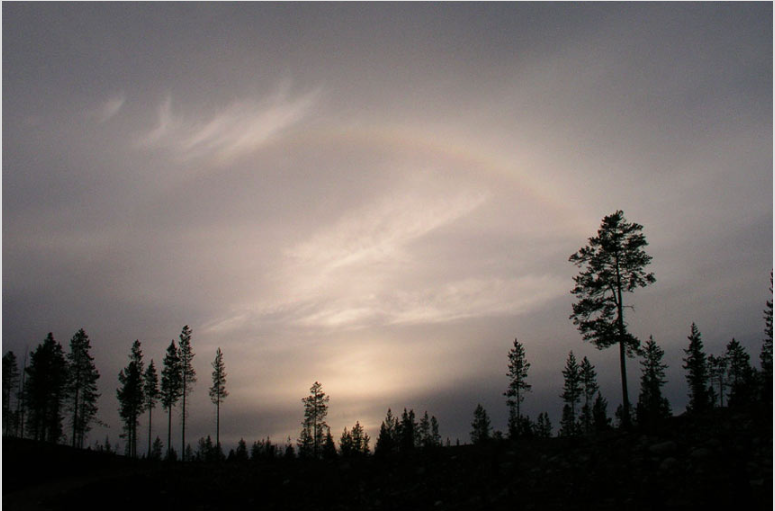22 degree halo Kola Peninsula Russia
Exploring the 22 Degree Halo Phenomenon in Russia's Kola Peninsula
Have you ever witnessed a captivating atmospheric optical phenomenon that left you in awe? One such mesmerizing event is the 22-degree halo, which occurs when a low sun casts a ring of light around it. In this article, we will delve into the intriguing occurrence of the 22-degree halo in Russia's Kola Peninsula, situated north of the Arctic Circle.
The Kola Peninsula, with its breathtaking landscapes and unique geographical location, provides an ideal setting for observing this stunning atmospheric display. On the 14th of June 2004, at 22:47 local time, Sergey Yeliseev had the privilege of capturing this enchanting moment near Kandalaksha, a town located at approximately 67°05'N, 33°06'E. The photograph taken by Yeliseev beautifully showcases the 22-degree halo phenomenon in all its glory.
Understanding the 22-Degree Halo
The 22-degree halo is a type of optical phenomenon that occurs when sunlight interacts with ice crystals suspended in the atmosphere. These ice crystals act as prisms, bending and refracting light, resulting in the formation of a circular ring around the sun or moon. The name "22-degree halo" stems from the fact that the ring has an approximate radius of 22 degrees around the celestial body.
Here are some key characteristics and details about the 22-degree halo:
- Shape: The halo appears as a perfect circle centered on the sun or moon.
- Size: With a radius of approximately 22 degrees, the halo spans a considerable portion of the sky.
- Color: The inner edge of the halo is typically reddish, while the outer edge appears bluish.
- Formation: The halo forms due to the refraction and reflection of sunlight by hexagonal ice crystals present in high-level cirrus clouds.
Atmospheric Conditions for the 22-Degree Halo
To witness the 22-degree halo, specific atmospheric conditions must be met. These conditions involve the presence of certain types of clouds and the position of the sun or moon in the sky. Here are the key factors contributing to the formation of the 22-degree halo:
- Cirrus Clouds: The halo is most commonly observed when high-level cirrus clouds are present. These thin, wispy clouds consist of ice crystals that serve as the necessary refracting medium.
- Sun or Moon Position: The sun or moon must be relatively low in the sky, usually below 45 degrees from the observer's horizon. This angle ensures that the light passes through a sufficient thickness of ice crystals to create the halo effect.
Other Atmospheric Optical Phenomena
While the 22-degree halo is undoubtedly captivating, it is not the only atmospheric optical phenomenon that can be observed in the Kola Peninsula or other locations around the world. Here are a few other intriguing phenomena that nature occasionally treats us to:
- Sundogs: Also known as parhelia, sundogs are bright spots of light that appear on either side of the sun, often accompanied by a halo. These colorful patches are caused by the refraction of sunlight by ice crystals.
- Circumzenithal Arc: This arc appears as an upside-down rainbow located directly above the sun. It is characterized by vibrant colors and is caused by sunlight passing through horizontally oriented ice crystals.
- Sun Pillar: Sun pillars are vertical columns of light that extend above or below the sun. They are created when sunlight interacts with plate-shaped ice crystals in the atmosphere.
Capturing the Beauty of Atmospheric Optics
Photographing atmospheric optical phenomena can be a rewarding and visually stunning experience. To capture the essence of these mesmerizing events, consider the following tips:
- Timing: Monitor weather conditions and be prepared to photograph during the optimal times when the sun or moon is low in the sky.
- Composition: Incorporate interesting elements in your composition, such as landscapes or silhouettes, to add depth and context to the image.
- Camera Settings: Experiment with different camera settings, such as exposure compensation and white balance, to achieve the desired effect and accurately capture the colors and details of the phenomenon.
- Patience: Atmospheric optical phenomena can be fleeting, so be patient and ready to capture the moment when it presents itself.
Conclusion
The 22-degree halo phenomenon in Russia's Kola Peninsula is a captivating display of nature's wonders. With its unique geographical location and atmospheric conditions, the region offers an excellent opportunity to witness and photograph this stunning optical event. Remember to keep an eye on the sky, as you never know when you might be fortunate enough to experience the ethereal beauty of the 22-degree halo or other atmospheric optical phenomena.

A low sun casts a 22º halo over Russia's Kola Peninsula north of the Arctic Circle . Taken by Sergey Yeliseev at 22:47 local time 14th June 2004 near Kandalaksha, 67 05'N, 33 06'E . ©2004 Sergey Yeliseev, shown with permission.
Note: this article has been automatically converted from the old site and may not appear as intended. You can find the original article here.
Reference Atmospheric Optics
If you use any of the definitions, information, or data presented on Atmospheric Optics, please copy the link or reference below to properly credit us as the reference source. Thank you!
-
<a href="https://atoptics.co.uk/blog/22-degree-halo-kola-peninsula-russia/">22 degree halo Kola Peninsula Russia</a>
-
"22 degree halo Kola Peninsula Russia". Atmospheric Optics. Accessed on November 26, 2024. https://atoptics.co.uk/blog/22-degree-halo-kola-peninsula-russia/.
-
"22 degree halo Kola Peninsula Russia". Atmospheric Optics, https://atoptics.co.uk/blog/22-degree-halo-kola-peninsula-russia/. Accessed 26 November, 2024
-
22 degree halo Kola Peninsula Russia. Atmospheric Optics. Retrieved from https://atoptics.co.uk/blog/22-degree-halo-kola-peninsula-russia/.